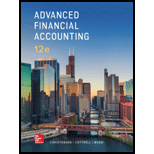
Concept explainers
a
Introduction:
Intercompany sale of bonds: When a company sells bonds to its subsidiary, all effects of the intercompany obligation must be eliminated. When the consolidated entity is viewed as a single company, all amounts related to obligations of consolidating companies on each other be eliminated, including all amounts related to intercompany investments.
Retirement of bonds: When a constrictive retirement takes place, the consolidated income statement for the year shows the profit or loss on retirement, but not reported in the consolidated
Requirement 1
The entries in the books of P related to investment in S for the year 20X2.
b
Introduction:
Intercompany sale of bonds: When a company sells bonds to its subsidiary, all effects of the intercompany obligation must be eliminated. When the consolidated entity is viewed as a single company, all amounts related to obligations of consolidating companies on each other be eliminated, including all amounts related to intercompany investments.
Retirement of bonds: When a constrictive retirement takes place, the consolidated income statement for the year shows the profit or loss on retirement, but not reported in the consolidated balance sheet, if the company purchases the bond of a related company from an unrelated party at a price equal to the value reported, the elimination entries required to be prepared in consolidated financial statement.
Requirement 2
The entries in books of P related to bond payable for 20X2.
c
Introduction:
Intercompany sale of bonds: When a company sells bonds to its subsidiary, all effects of the intercompany obligation must be eliminated. When the consolidated entity is viewed as a single company, all amounts related to obligations of consolidating companies on each other be eliminated, including all amounts related to intercompany investments.
Retirement of bonds: When a constrictive retirement takes place, the consolidated income statement for the year shows the profit or loss on retirement, but not reported in the consolidated balance sheet, if the company purchases the bond of a related company from an unrelated party at a price equal to the value reported, the elimination entries required to be prepared in consolidated financial statement.
Requirement 3
The entries in books of T related to investment in P’s bonds for 20X2.
d
Introduction:
Intercompany sale of bonds: When a company sells bonds to its subsidiary, all effects of the intercompany obligation must be eliminated. When the consolidated entity is viewed as a single company, all amounts related to obligations of consolidating companies on each other be eliminated, including all amounts related to intercompany investments.
Retirement of bonds: When a constrictive retirement takes place, the consolidated income statement for the year shows the profit or loss on retirement, but not reported in the consolidated balance sheet, if the company purchases the bond of a related company from an unrelated party at a price equal to the value reported, the elimination entries required to be prepared in consolidated financial statement.
Requirement 4
The entries elimination entries to complete consolidation worksheet for 20X2.
e
Introduction:
Intercompany sale of bonds: When a company sells bonds to its subsidiary, all effects of the intercompany obligation must be eliminated. When the consolidated entity is viewed as a single company, all amounts related to obligations of consolidating companies on each other be eliminated, including all amounts related to intercompany investments.
Retirement of bonds: When a constrictive retirement takes place, the consolidated income statement for the year shows the profit or loss on retirement, but not reported in the consolidated balance sheet, if the company purchases the bond of a related company from an unrelated party at a price equal to the value reported, the elimination entries required to be prepared in consolidated financial statement.
Requirement 5
The preparation of consolidation worksheet for 20X2
Want to see the full answer?
Check out a sample textbook solution
Chapter 8 Solutions
EBK ADVANCED FINANCIAL ACCOUNTING
 Intermediate Accounting: Reporting And AnalysisAccountingISBN:9781337788281Author:James M. Wahlen, Jefferson P. Jones, Donald PagachPublisher:Cengage Learning
Intermediate Accounting: Reporting And AnalysisAccountingISBN:9781337788281Author:James M. Wahlen, Jefferson P. Jones, Donald PagachPublisher:Cengage Learning Financial Reporting, Financial Statement Analysis...FinanceISBN:9781285190907Author:James M. Wahlen, Stephen P. Baginski, Mark BradshawPublisher:Cengage Learning
Financial Reporting, Financial Statement Analysis...FinanceISBN:9781285190907Author:James M. Wahlen, Stephen P. Baginski, Mark BradshawPublisher:Cengage Learning Cornerstones of Financial AccountingAccountingISBN:9781337690881Author:Jay Rich, Jeff JonesPublisher:Cengage Learning
Cornerstones of Financial AccountingAccountingISBN:9781337690881Author:Jay Rich, Jeff JonesPublisher:Cengage Learning


